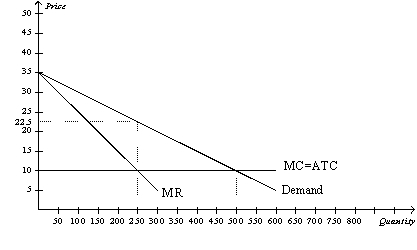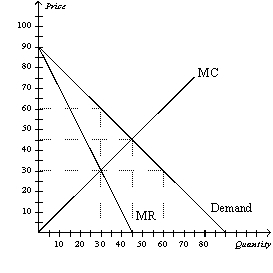A) geographical location.
B) age.
C) income.
D) All of the above are correct.
F) None of the above
Correct Answer

verified
Correct Answer
verified
Multiple Choice
Table 14-17
 -Refer to Table 14-17.If a monopolist faces a constant marginal cost of $3,how much output should the firm produce in order to equate marginal revenue with marginal cost?
-Refer to Table 14-17.If a monopolist faces a constant marginal cost of $3,how much output should the firm produce in order to equate marginal revenue with marginal cost?
A) 3 units
B) 4 units
C) 5 units
D) 6 units
F) A) and C)
Correct Answer

verified
Correct Answer
verified
Multiple Choice
Figure 14-16  -Refer to Figure 14-16.If there are no fixed costs of production,monopoly profit without price discrimination equals
-Refer to Figure 14-16.If there are no fixed costs of production,monopoly profit without price discrimination equals
A) $0.
B) $1,562.50.
C) $3,125.
D) $6,250.
F) None of the above
Correct Answer

verified
Correct Answer
verified
Multiple Choice
For a long while,electricity producers were thought to be a classic example of a natural monopoly.People held this view because
A) the average cost of producing units of electricity by one producer in a specific region was lower than if the same quantity were produced by two or more producers in the same region.
B) the average cost of producing units of electricity by one producer in a specific region was higher than if the same quantity were produced by two or more produced in the same region.
C) the marginal cost of producing units of electricity by one producer in a specific region was higher than if the same quantity were produced by two or more producers in the same region.
D) electricity is a special non-excludable good that could never be sold in a competitive market.
F) A) and B)
Correct Answer

verified
Correct Answer
verified
Multiple Choice
Figure 14-14  -Refer to Figure 14-14.To maximize total surplus,a benevolent social planner would choose which of the following outcomes?
-Refer to Figure 14-14.To maximize total surplus,a benevolent social planner would choose which of the following outcomes?
A) Q = 30 and P = 30
B) Q = 30 and P = 60
C) Q = 45 and P = 45
D) Q = 60 and P = 30
F) A) and B)
Correct Answer

verified
Correct Answer
verified
Multiple Choice
When a monopolist increases the amount of output that it produces and sells,average revenue
A) increases,and marginal revenue increases.
B) increases,and marginal revenue decreases.
C) decreases,and marginal revenue increases.
D) decreases,and marginal revenue decreases.
F) None of the above
Correct Answer

verified
Correct Answer
verified
Multiple Choice
Which of the following is a characteristic of a natural monopoly?
A) Fixed costs are typically a small portion of total costs.
B) Average total cost declines over large regions of output.
C) The product sold is a natural resource such as diamonds or water.
D) All of the above are correct.
F) B) and C)
Correct Answer

verified
Correct Answer
verified
Multiple Choice
Granting a pharmaceutical company a patent for a new medicine will lead to (i) a product that is priced higher than it would be without the exclusive rights. (ii) incentives for pharmaceutical companies to invest in research and development. (iii) higher quantities of output than without the patent.
A) (i) and (ii) only
B) (ii) and (iii) only
C) (i) and (iii) only
D) (i) ,(ii) ,and (iii)
F) A) and B)
Correct Answer

verified
Correct Answer
verified
Multiple Choice
With no price discrimination,the monopolist sells every unit at the same price.Therefore
A) marginal revenue is equal to price.
B) marginal revenue is equal to average revenue.
C) price is greater than marginal revenue.
D) Both a and b are correct.
F) C) and D)
Correct Answer

verified
Correct Answer
verified
Multiple Choice
If a profit-maximizing monopolist faces a downward-sloping market demand curve,its
A) average revenue is less than the price of the product.
B) average revenue is less than marginal revenue.
C) marginal revenue is less than the price of the product.
D) marginal revenue is greater than the price of the product.
F) A) and C)
Correct Answer

verified
Correct Answer
verified
Multiple Choice
Table 14-11
The following table shows quantity,price,and marginal cost information for a monopoly:
 -Refer to Table 14-11.What level of output should the firm produce to maximize its profit?
-Refer to Table 14-11.What level of output should the firm produce to maximize its profit?
A) 2 units
B) 3 units
C) 4 units
D) 5 units
F) A) and B)
Correct Answer

verified
Correct Answer
verified
True/False
When a monopolist increases the quantity that it sells,price decreases,which,all else equal,decreases total revenue; this is called the price effect.
B) False
Correct Answer

verified
Correct Answer
verified
Multiple Choice
Suppose a monopolist chooses the price and production level that maximizes its profit.From that point,to increase society's economic welfare,output would need to be increased as long as
A) average revenue exceeds marginal cost.
B) average revenue exceeds average total cost.
C) marginal revenue exceeds marginal cost.
D) marginal revenue exceeds average total cost.
F) A) and C)
Correct Answer

verified
Correct Answer
verified
True/False
One characteristic of a monopoly market is that the product is virtually identical to products produced by competing firms.
B) False
Correct Answer

verified
Correct Answer
verified
True/False
In a monopoly market,the socially efficient quantity of output is typically higher than the profit-maximizing quantity of output for the monopolist.
B) False
Correct Answer

verified
Correct Answer
verified
Multiple Choice
Scenario 14-5 An airline knows that there are two types of travelers: business travelers and vacationers.For a particular flight,there are 100 business travelers who will pay $600 for a ticket while there are 50 vacationers who will pay $300 for a ticket.There are 150 seats available on the plane.Suppose the cost to the airline of providing the flight is $20,000,which includes the cost of the pilots,flight attendants,fuel,etc. -Refer to Scenario 14-5.How much profit will the airline earn if it sets the price of each ticket at $300?
A) -$15,000
B) -$5,000
C) $25,000
D) $45,000
F) All of the above
Correct Answer

verified
Correct Answer
verified
Multiple Choice
For a monopolist,when the output effect is greater than the price effect,marginal revenue is
A) positive.
B) negative.
C) zero.
D) maximized.
F) A) and B)
Correct Answer

verified
Correct Answer
verified
Multiple Choice
When a firm's average total cost curve continually declines,the firm is a
A) government-created monopoly.
B) natural monopoly.
C) revenue monopoly.
D) All of the above are correct.
F) None of the above
Correct Answer

verified
Correct Answer
verified
Multiple Choice
The monopolist's profit-maximizing quantity of output is determined by the intersection of which of the following two curves?
A) marginal cost and demand
B) marginal cost and marginal revenue
C) average total cost and marginal revenue
D) average variable cost and average revenue
F) A) and B)
Correct Answer

verified
Correct Answer
verified
Multiple Choice
For a monopolist,
A) average revenue is always greater than the price of the good.
B) marginal revenue is always less than the price of the good.
C) marginal cost is always greater than average total cost.
D) marginal revenue equals marginal cost at the point where total revenue is maximized.
F) A) and B)
Correct Answer

verified
Correct Answer
verified
Showing 481 - 500 of 526
Related Exams